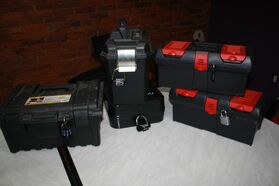group task, which has many uses: team building for companies, bonding for small groups, or fun for parties - all of which provide a memorable experience. The rooms can take place anywhere, requiring only a few supplies and a moderator. By solving various locked boxes or simulated locks on a computer that lead to further clues, the group works their way “out.” Each game challenges students to solve a series of problems creatively, all while working together against the clock.
Breakout rooms across the nation have a variety of themes: bank robbing, old-west, time warp, panic room, mythology, arcade, treasure hunting, murder mystery, etc. Our breakout rooms also carry a theme, such as a Christmas room with clues based on “The Night Before Christmas” story, by Clement Clarke Moore and the “Universal Man” based on Leonardo Da Vinci. While the themed breakout puzzles allow the teaching of a variety of facts and concepts, it is interesting to watch and discuss the dynamics of the team with the group after they complete the task and “break out.” In doing so, we were able to hear them discuss their takeaways: the development of their communication skills as they collaborated on the challenge, how the team dynamic evolved, and what leadership skills were used to guide their group to success. The team members soon realized they need a variety of different types of thinking skills to solve these puzzles. For teens at Crosswalk, they are more apt to retain the knowledge they gleaned and, best of all, students learn important problem-solving skills along the way. Problem solving skills and techniques offer opportunities for different kinds of thinking; rather than just the provided facts, teams must use abstract tangent problem solving, such as deciphering color patterns or sound patterns that lead to the clue. The diversity of the skills needed to “break out” of these room allows the players to value the unique thinking of each individual and learn some real life skills. In a practical sense, the challenges reinforce the need for all members of the team to be valued and that success depends on getting the best from each member of the team. Furthermore, with challenges they can’t immediately solve, but are motivated to stick with, they try many different strategies in order to complete the task. This is good experience for when they encounter questions they don’t know how to solve—or any other challenges in their lives. From here, the plan is to run a breakout room once a month, as the benefits of the activity lead to students using their critical thinking, collaboration, creativity, and communication to achieve “breaking free.” The prize for their efforts? Teens come out of the breakout room with a sense of pride and confidence after taking on a challenge and achieving their goal.
0 Comments
Leave a Reply. |
Archives
June 2023
Categories |
© 2023 Crosswalk Teen Center. All rights reserved.



 RSS Feed
RSS Feed